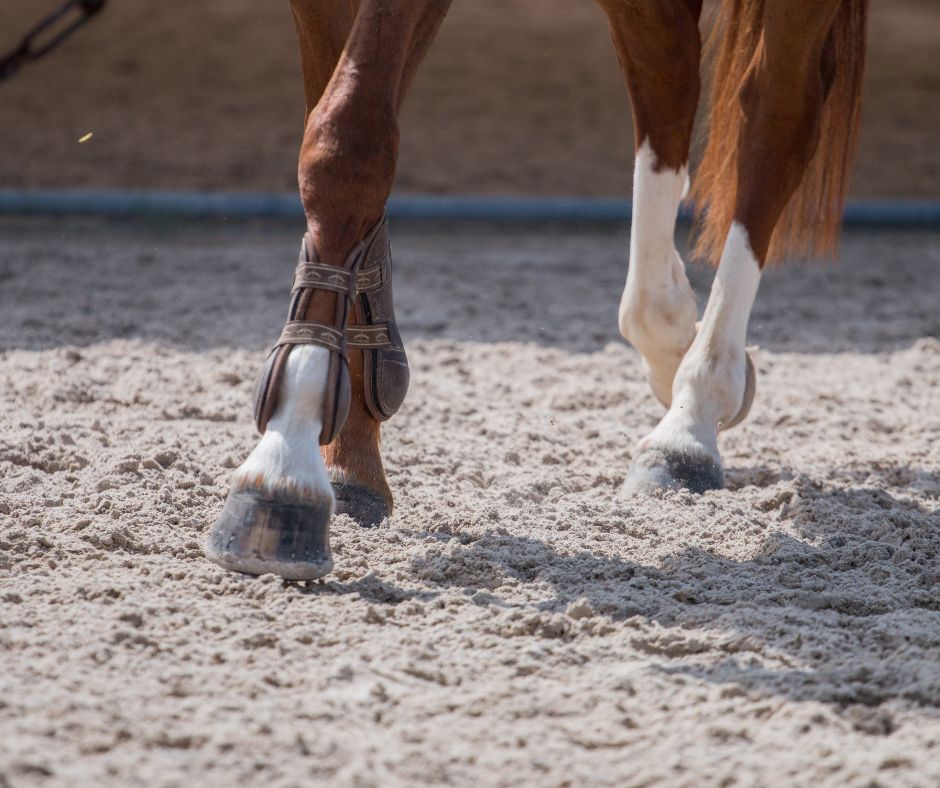Preventing Tendon and Ligament Injuries in Horses
By Siun Griffin, Veterinary Physiotherapist and LCAO Community Manager
Tendons and ligaments are vital components of a horse’s musculoskeletal system, playing crucial roles in supporting and stabilizing their limbs during movement.
However, they are susceptible to injuries that can be severe and difficult to treat. As responsible horse owners, it is essential to understand what tendons and ligaments are, recognize signs of injury, and implement preventive measures to ensure the well-being and performance of our equine companions.
What are Tendons and Ligaments?
1. Tendons
Tendons are tough, fibrous connective tissues that attach muscles to bones. They transmit the force generated by muscles to the bones, enabling movement and providing stability to the joints.
2. Ligaments
Ligaments are similar to tendons but differ in their function. They connect bones to other bones and are essential for stabilizing joints, limiting excessive movement, and preventing injuries during strenuous activities.
Signs of Tendon or Ligament Injuries
- Lameness: A horse with a tendon or ligament injury may exhibit lameness, which can vary in severity depending on the extent of the injury.
- Swelling: Swelling around the affected area is a common sign of an injury. It may be localized or diffuse, depending on the severity and location of the damage.
- Heat and Pain: Injured tendons or ligaments can cause heat and pain, which can be detected through palpation.
- Reluctance to Bear Weight: Horses with tendon or ligament injuries may be reluctant to put weight on the affected limb, particularly when turning or on uneven surfaces.
- Changes in Gait: A horse with an injury may show alterations in its gait, such as shortened strides or uneven movement.
- Decreased Performance: Tendon and ligament injuries can lead to reduced performance levels, making it difficult for the horse to perform its usual activities.
- Reluctance to work: Sometimes tension and ligament injuries have much more subtle signs. Some horses might show what would be considered behavioral problems under saddle, but not show some of the signs listed above.
Preventing Tendon and Ligament Injuries in Horses
1. Proper Warm-Up and Cool-Down
Always begin any exercise session with a proper warm-up routine and conclude with a gradual cool-down to prepare the tendons and ligaments for work and reduce the risk of injury.
2. Regular Exercise
Consistent, appropriate exercise helps strengthen the tendons and ligaments, making them more resilient to injury.
3. Balanced Nutrition
Provide a well-balanced diet with essential nutrients like proteins, vitamins, and minerals to support overall musculoskeletal health.
4. Correct Footing
Ensure that the footing in training and exercise areas is suitable for the horse’s activity level, as inappropriate footing can stress tendons and ligaments.
5. Proper Hoof Care
Regular hoof trimming and shoeing by a skilled farrier can aid in maintaining proper limb alignment, reducing the risk of injuries. Poor hoof balance puts more stress on the limbs and body.
6. Gradual Conditioning
Avoid sudden increases in workload, as this can strain the tendons and ligaments. Gradually increase exercise intensity and duration to allow the body to adapt. Doing too much too soon can increase the risk of injury.
7. Regular Veterinary Checkups
Schedule regular checkups with a qualified equine veterinarian to detect and address any potential issues before they escalate.
8. Quality Tack and Equipment
Ensure that saddles, bridles, and other tack fit properly to minimize pressure on the horse’s limbs during exercise.
9. Cross-Training
Engage in a variety of activities to avoid repetitive stress on specific tendons and ligaments, promoting overall strength and flexibility.
10. Weight Management
We all want our horses to hold a nice condition but being too fat will add more strain on the tendons, ligaments, and joints which can lead to several issues, not just increase the risk of tendon injury.
11. Limb Protection
It is a good idea to always use front tendon boots on a horse when it is doing work. Of course, there are some exceptions, such as long trail rides where the boots might not be suitable and no fast work is being done.
Boots reduce the risk of strike injuries to the vulnerable lower limb. Try to use boots that offer some ventilation and always remove them immediately after exercise as they create heat in the tendons.
Choose boots carefully to ensure you are using ones that offer less heat build-up and avoid working a horse with bandages.
It is also a good idea to use overreach boots when lunging as doing fast work on a circle increases the likelihood of overreach injuries.
12. Cool the Limbs
Studies have shown that as temperature increases in the limb’s tendons and ligaments with exercise so does the risk of injury. This is why it is important to remove boots immediately.
Cooling the legs with cold water or ice after exercise will help bring temperatures down more quickly and reduce injury risk.
Final Thoughts
Preventing tendon and ligament injuries in horses is crucial for maintaining their well-being and performance.
Understanding the signs of injuries and implementing preventive measures, such as proper warm-up, balanced nutrition, and regular exercise, will go a long way in ensuring your horse’s health and longevity.
Always consult with equine experts and veterinarians for personalized advice and guidance in caring for your horse’s musculoskeletal system.

